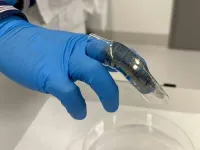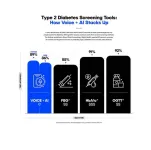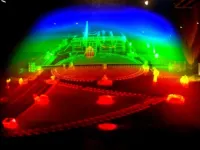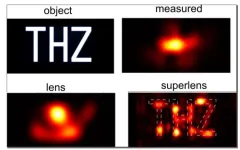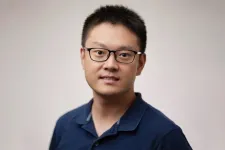(Press-News.org) Researchers have invented an experimental wearable device that generates power from a user’s bending finger and can create and store memories, in a promising step towards health monitoring and other technologies.
The innovation features a single nanomaterial incorporated into a stretchable casing fitted to a person’s finger. The nanomaterial enabled the device to generate power with the user bending their finger.
The super-thin material also allows the device to perform memory tasks, as outlined below.
Multifunctional devices normally require several materials in layers, which involves the time-consuming challenge of stacking nanomaterials with high precision.
The team, led by RMIT University and the University of Melbourne in collaboration with other Australian and international institutions, made the proof-of-concept device with the rust of a low-temperature liquid metal called bismuth, which is safe and well suited for wearable applications.
Senior lead researcher Dr Ali Zavabeti said the invention could be developed to create medical wearables that monitor vital signs – incorporating the researchers’ recent work with a similar material that enabled gas sensing – and memorise personalised data.
“The innovation was used in our experiments to write, erase and re-write images in nanoscale, so it could feasibly be developed to one day encode bank notes, original art or authentication services,” said Zavabeti, an engineer from RMIT and the University of Melbourne.
The team’s research is published in Advanced Functional Materials.
What did the device achieve in experiments?
The team says the study revealed their invention exhibits “exceptional responsiveness to movements associated with human activities, such as stretching, making it a promising candidate for wearable technologies".
“We tested natural motion behaviour with the device attached to a finger joint, with an average output peak of about 1 volt,” Zavabeti said.
The device was able to perform the memory functions of “read", “write” and “erase", which included using the RMIT logo and a square-shaped insignia as demonstrations of these capabilities. The device, which was not worn by a user during these memory experiments, wrote and stored the logo and symbol in a space that could fit 20 times within the width of a human hair.
How did the team make the invention and how does it work?
Lead author and PhD student Xiangyang Guo from RMIT, said the team can print layers of bismuth rust, otherwise known as oxide, in just a few seconds.
“We fundamentally investigated this instant-printing technique for the first time using low-melting point liquid metals,” said Guo, who works under the supervision of Dr Ali Zavabeti and Professor Yongxiang Li.
The team demonstrated that engineering materials at the nanoscale can present enormous opportunities in a range of functions, from sensing and energy harvesting to memory applications, he said.
“Bismuth oxide can be engineered to provide memory functionality, which is critical for many applications,” Guo said.
“The material can act as a semiconductor, meaning it can be used for computation.
“It is a nanogenerator, meaning it is energy efficient with a green energy supply from environmental vibrations and mechanical movements.”
Guo said bismuth oxide was likely to cause less irritation to skin, compared with silicon, and it was durable, so it was stretchable and can be integrated into wearable technologies.
Next steps
The team is keen to collaborate with industry partners to further develop and prototype this invention.
The researchers plan to adapt their approach for other low-temperature liquid and solid metals and alloys that could be developed for personalised wearables.
Support for the research
The Australian Research Council funded the research, which was also supported by the National Computational Infrastructure, as well as the Microscopy and Microanalysis Facility (RMMF) and Micro Nano Research Facility (MNRF) at RMIT and the Department of Chemical Engineering and Physics at the University of Melbourne.
The team included researchers from the University of Toronto, Western Sydney University, University of Sydney, University of New South Wales and Australian National University.
The researchers’ peer-reviewed article, “Multi-Functional Atomically Thin Oxides from Bismuth Liquid Metal”, is published in Advanced Functional Materials (DOI: 10.1002/adfm.202307348).
Researchers have invented an experimental wearable device that generates power from a user’s bending finger and can create and store memories, in a promising step towards health monitoring and other technologies.
The innovation features a single nanomaterial incorporated into a stretchable casing fitted to a person’s finger. The nanomaterial enabled the device to generate power with the user bending their finger.
The super-thin material also allows the device to perform memory tasks, as outlined below.
Multifunctional devices normally require several materials in layers, which involves the time-consuming challenge of stacking nanomaterials with high precision.
The team, led by RMIT University and the University of Melbourne in collaboration with other Australian and international institutions, made the proof-of-concept device with the rust of a low-temperature liquid metal called bismuth, which is safe and well suited for wearable applications.
Senior lead researcher Dr Ali Zavabeti said the invention could be developed to create medical wearables that monitor vital signs – incorporating the researchers’ recent work with a similar material that enabled gas sensing – and memorise personalised data.
“The innovation was used in our experiments to write, erase and re-write images in nanoscale, so it could feasibly be developed to one day encode bank notes, original art or authentication services,” said Zavabeti, an engineer from RMIT and the University of Melbourne.
The team’s research is published in Advanced Functional Materials.
What did the device achieve in experiments?
The team says the study revealed their invention exhibits “exceptional responsiveness to movements associated with human activities, such as stretching, making it a promising candidate for wearable technologies".
“We tested natural motion behaviour with the device attached to a finger joint, with an average output peak of about 1 volt,” Zavabeti said.
The device was able to perform the memory functions of “read", “write” and “erase", which included using the RMIT logo and a square-shaped insignia as demonstrations of these capabilities. The device, which was not worn by a user during these memory experiments, wrote and stored the logo and symbol in a space that could fit 20 times within the width of a human hair.
How did the team make the invention and how does it work?
Lead author and PhD student Xiangyang Guo from RMIT, said the team can print layers of bismuth rust, otherwise known as oxide, in just a few seconds.
“We fundamentally investigated this instant-printing technique for the first time using low-melting point liquid metals,” said Guo, who works under the supervision of Dr Ali Zavabeti and Professor Yongxiang Li.
The team demonstrated that engineering materials at the nanoscale can present enormous opportunities in a range of functions, from sensing and energy harvesting to memory applications, he said.
“Bismuth oxide can be engineered to provide memory functionality, which is critical for many applications,” Guo said.
“The material can act as a semiconductor, meaning it can be used for computation.
“It is a nanogenerator, meaning it is energy efficient with a green energy supply from environmental vibrations and mechanical movements.”
Guo said bismuth oxide was likely to cause less irritation to skin, compared with silicon, and it was durable, so it was stretchable and can be integrated into wearable technologies.
Next steps
The team is keen to collaborate with industry partners to further develop and prototype this invention.
The researchers plan to adapt their approach for other low-temperature liquid and solid metals and alloys that could be developed for personalised wearables.
Support for the research
The Australian Research Council funded the research, which was also supported by the National Computational Infrastructure, as well as the Microscopy and Microanalysis Facility (RMMF) and Micro Nano Research Facility (MNRF) at RMIT and the Department of Chemical Engineering and Physics at the University of Melbourne.
The team included researchers from the University of Toronto, Western Sydney University, University of Sydney, University of New South Wales and Australian National University.
The researchers’ peer-reviewed article, “Multi-Functional Atomically Thin Oxides from Bismuth Liquid Metal”, is published in Advanced Functional Materials (DOI: 10.1002/adfm.202307348).
MULTIMEDIA AVAILABLE
This video (https://www.youtube.com/watch?v=zikAX3MUt1Q) can be shared by media.
In addition to the video, high-res photos and b-roll footage related to the research are available for download here: https://cloudstor.aarnet.edu.au/plus/s/1IJ4KEHw9nlKMqG
END
Wearable device makes memories and powers up with the flex of a finger
2023-10-18
ELSE PRESS RELEASES FROM THIS DATE:
AI and 10 seconds of voice can screen for diabetes, new study reveals
2023-10-18
Determining whether a person is diabetic could be as easy as having them speak a few sentences into their smartphone, according to a groundbreaking study from Klick Labs that combines voice technology with artificial intelligence in a major step forward in diabetes detection.
The new study, published in Mayo Clinic Proceedings: Digital Health, outlines how scientists used six to 10 seconds of people’s voice, along with basic health data, including age, sex, height, and weight, to create an AI model ...
AI identifies antimalarial drug as possible osteoporosis treatment
2023-10-18
Correction (Oct. 17, 2023): The paper’s title has been corrected to “Deep Learning-Predicted Dihydroartemisinin Rescues Osteoporosis by Maintaining Mesenchymal Stem Cell Stemness through Activating Histone 3 Lys 9 Acetylation
Artificial intelligence has exploded in popularity and is being harnessed by some scientists to predict which molecules could treat illnesses, or to quickly screen existing medicines for new applications. Researchers reporting in ACS Central Science have used one such deep learning algorithm, and found that dihydroartemisinin ...
Simplifying the generation of three-dimensional holographic displays
2023-10-18
Holograms that offer a three-dimensional (3D) view of objects provide a level of detail that is unattainable by regular two-dimensional (2D) images. Due to their ability to offer a realistic and immersive experience of 3D objects, holograms hold enormous potential for use in various fields, including medical imaging, manufacturing, and virtual reality. Holograms are traditionally constructed by recording the three-dimensional data of an object and the interactions of light with the object. However, this technique is computationally highly intensive as it requires ...
Superlensing without a super lens: physicists boost microscopes beyond limits
2023-10-18
Ever since Antonie van Leeuwenhoek discovered the world of bacteria through a microscope in the late seventeenth century, humans have tried to look deeper into the world of the infinitesimally small.
There are, however, physical limits to how closely we can examine an object using traditional optical methods. This is known as the ‘diffraction limit’ and is determined by the fact that light manifests as a wave. It means a focused image can never be smaller than half the wavelength of light used to observe an object.
Attempts to break this limit with “super lenses” have all hit the hurdle of extreme visual losses, making the lenses opaque. ...
Collaborative study focuses on using computer algorithms to find molecular adaptations to improve COVID-19 drugs
2023-10-18
As the COVID-19 pandemic scattered and isolated people, researchers across Virginia Tech connected for a data-driven collaboration seeking improved drugs to fight the disease and potentially many other illnesses.
A multidisciplinary collaboration spanning several colleges at Virginia Tech resulted in a newly published study, “Data Driven Computational Design and Experimental Validation of Drugs for Accelerated Mitigation of Pandemic-like Scenarios,” in the Journal of Physical Chemistry Letters.
The study focuses on using computer algorithms to generate adaptations to ...
Study predicts potential for 110% electricity increases in U.S. urban buildings
2023-10-18
A research study led by University of Oklahoma assistant professor Chenghao Wang and recently published in the journal Nature Communications tackled the critical issue of how city-scale building energy consumption in urban environments will evolve under the influence of climate change.
Fossil fuels account for approximately 40% of all building energy use in urban city centers in the United States, and the U.S. Energy Information Administration reports that residential and commercial buildings in U.S. cities are one of the major energy ...
Open access: Need to move away from transformative agreements
2023-10-18
Sweden is far ahead when it comes to promoting open access to scholarly publications. But there is risk of getting stuck in a permanent transformation that favours large commercial publishers. A new report from the Association of Swedish Higher Education Institutions develops a strategy on how to work in negotiations with the publishers.
In 2021, the Association of Swedish Higher Education Institutions (Sveriges universitets- och högskoleförbund, SUHF) convened a “Beyond transformative agreements” working group (the BTA group) to lay the foundation for further advancing the transition to open access. Now, the group ...
Graz University of Technology study on e-scooter accidents: more helmets and less speed reduce the injury risk
2023-10-18
The use of e-scooters has increased significantly in recent years, but so has the number of accidents involving this relatively new form of transport. At the same time, knowledge about injury mechanisms in this area was still very limited. In the project SURF, funded by Zukunftsfonds Steiermark, the Vehicle Safety Institute at Graz University of Technology (TU Graz) investigated this topic using Human Body Models and derived recommendations to reduce the injury risk in e-scooter accidents.
Put on a helmet, decrease speed and get off the pavement
As ...
Reef-devouring predator survives coral bleaching and feasts on the survivors
2023-10-18
Research conducted by marine biologists from the University of Sydney has found juvenile crown-of-thorns starfish can withstand tremendous heatwaves well above levels that kill coral. These starfish then develop into carnivorous predators that devour reefs just as they begin to regrow.
Crown-of-thorns starfish are native to the Great Barrier Reef and found in the Indo-Pacific region, but they are classified as a species of concern because the damage large populations cause to coral is more significant than any other species. ...
Does SARS-CoV-2 infection have urological effects?
2023-10-18
Research published in the Journal of Internal Medicine indicates that SARS-CoV-2 infection may worsen lower urinary tract symptoms (LUTS) in men.
The study included 17,986 men receiving medication for LUTS within the public healthcare system of Hong Kong in 2021–2022, half of whom had SARS-CoV-2 infection. The group with SARS-CoV-2 had significantly higher rates of retention of urine (4.55% versus 0.86%); blood in the urine (1.36% versus 0.41%); clinical urinary tract infection (4.31% versus 1.49%); bacteria in the urine (9.02% versus 1.97%); and addition of 5-alpha reductase inhibitors, which are drugs prescribed for enlarged prostate. (0.50% versus 0.02%). These urological ...
